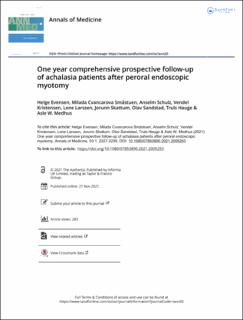| dc.contributor.author | Evensen, Helge | |
| dc.contributor.author | Småstuen, Milada Cvancarova | |
| dc.contributor.author | Schulz, Anselm | |
| dc.contributor.author | Kristensen, Vendel Ailin | |
| dc.contributor.author | Larssen, Lene | |
| dc.contributor.author | Skattum, Jorunn Pettersen | |
| dc.contributor.author | Sandstad, Olav | |
| dc.contributor.author | Hauge, Truls | |
| dc.contributor.author | Medhus, Asle Wilhelm | |
| dc.date.accessioned | 2022-04-05T09:16:36Z | |
| dc.date.available | 2022-04-05T09:16:36Z | |
| dc.date.created | 2021-12-02T14:47:44Z | |
| dc.date.issued | 2021 | |
| dc.identifier.citation | Annals of Medicine. 2021, 53 (1), 2227-2235. | en_US |
| dc.identifier.issn | 0785-3890 | |
| dc.identifier.uri | https://hdl.handle.net/11250/2989859 | |
| dc.description.abstract | Peroral endoscopic myotomy (POEM) is an established therapy for achalasia, but outcome evaluation has often been limited to Eckardt score (ES). The present study was aimed to improve knowledge about outcome evaluation and predictive outcome factors by performing a comprehensive objective evaluation of achalasia patients treated by POEM. Methods: This single centre prospective study reports outcome data 12 months after POEM in treatment-naive achalasia patients. A predefined follow-up protocol included ES, high resolution manometry, 24-h pH measurement, upper endoscopy and timed barium esophagogram (TBE). Univariate and multivariate regression analyses were performed to analyze association between post-POEM variables and identify predictive factors for objective outcome. Results: Fifty patients were included with a drop-out rate of < .001), and 28% (13/47) of the patients had a positive 24-h pH registration. An oesophageal diameter >3 cm after POEM was associated with treatment failure assessed by ES (p ¼ .04) and TBE (p ¼ .03). Advanced achalasia stage (p ¼ .02) and long symptom duration (p ¼ .04) were identified as independent predictive factors for poor outcome assessed by TBE. Conclusions: The present study confirms that POEM is an efficient therapy for achalasia. The comprehensive objective evaluation after POEM demonstrates that long symptom duration and major changes in oesophageal anatomy at diagnosis imply poor treatment outcome, and a post-POEM dilated oesophagus is associated with treatment failure. | en_US |
| dc.language.iso | eng | en_US |
| dc.publisher | Taylor & Francis Open Access | en_US |
| dc.rights | Navngivelse 4.0 Internasjonal | * |
| dc.rights.uri | http://creativecommons.org/licenses/by/4.0/deed.no | * |
| dc.subject | Achalasia | en_US |
| dc.subject | Gastroesophageal reflux disease | en_US |
| dc.subject | Peroral endoscopic myotomy | en_US |
| dc.subject | Evaluation | en_US |
| dc.title | One year comprehensive prospective follow-up of achalasia patients after peroral endoscopic myotomy | en_US |
| dc.type | Peer reviewed | en_US |
| dc.type | Journal article | en_US |
| dc.description.version | publishedVersion | en_US |
| cristin.ispublished | true | |
| cristin.fulltext | original | |
| cristin.qualitycode | 1 | |
| dc.identifier.doi | 10.1080/07853890.2021.2005253 | |
| dc.identifier.cristin | 1963547 | |
| dc.source.journal | Annals of Medicine | en_US |
| dc.source.volume | 53 | en_US |
| dc.source.issue | 1 | en_US |
| dc.source.pagenumber | 2227-2235 | en_US |

